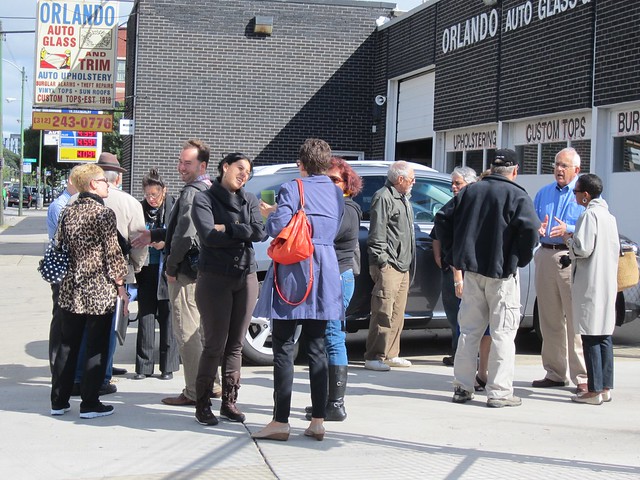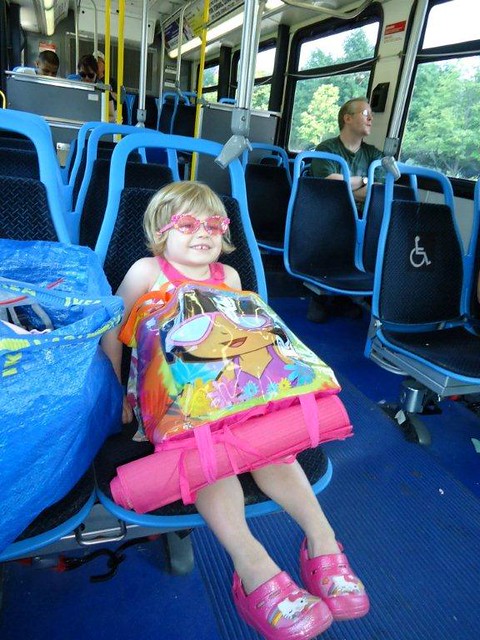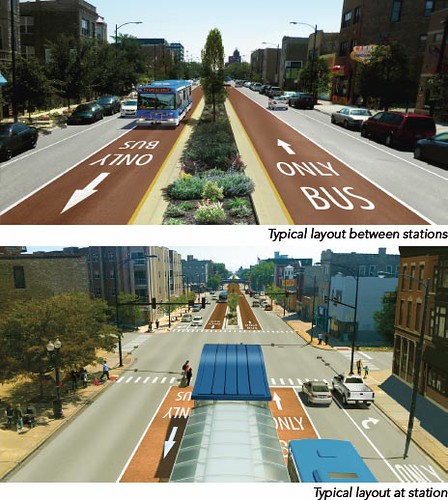Last week I dropped by the photo op and interview session the anti-bus rapid transit group the Ashland-Western Coalition helped organize for the Sun-Times at Orlando Glass and Trim in Noble Square. As I stood off to the side snapping photos for Streetsblog, it was a pleasant surprise when one of the BRT opponents walked up to me with a smile and introduced herself.
Suzi Wahl described herself as an “avid cyclist” who even used to pedal in Chicago Critical Mass, although she stopped participating after witnessing an enraged driver intentionally strike a group of cyclists, including a ten-year-old boy, during the monthly ride. She said she’d be interested in talking to me in the future about her perspective as a sustainable transportation advocate who opposes the CTA’s plan to convert car lanes on Ashland Avenue to dedicated bus lanes.
Until recently, coalition leader Roger Romanelli had been the main spokesperson for the anti-BRT movement. However, shortly before the interview session, Wahl and her husband Bill Dahms contacted multiple media outlets about their fears that the lane conversion, along with the prohibition of most left turns, will send aggravated drivers racing down side streets. Since then Wahl, a young mom who lives about half a mile west of Ashland in Ukrainian Village and doesn’t count herself as a member of the AWC but an ally, has emerged as a sympathetic face of the opposition, appearing in many news stories.
During the interview, she told the Sun-Times that the benefits of BRT are “not worth the tradeoffs in quality of life.” Soon afterwards she appeared in an NBC story asking, "How many cars are going to be in my neighborhood? … You're not really looking at typical automobile traffic, you'll be looking at frustrated drivers."
A DNAInfo writeup of a recent BRT info session quoted Wahl voicing her concerns about the side street issue to a CTA rep, noting that the agency estimates 35 percent of traffic on Ashland will be diverted onto other streets. “Where exactly will those vehicles shift to?” she asked. She also told an ABC news reporter, "As a mother, as a homeowner, as a landlord, I'm concerned with these frustrated drivers going through our neighborhoods."
When we talked on the phone, Wahl, who works in sales for an airline, told me she herself rarely drives. She said she often rides a bicycle, and although she doesn’t feel comfortable transporting her five-year-old daughter Lily by bike on city streets, she walks her to school and they often ride CTA buses. “It’s so easy to get around with my daughter that way,” she said. “We only have one car, and the only time we really use it is in very inclement weather or to take our bikes to a bike path. If there was a way to do BRT where we could have two car lanes in each direction, the bus lanes, parking, and maybe bike lanes, I’d be all for it.”
However, Wahl told me she fears that the planned reconfiguration of Ashland will lead to angry, erratic behavior from drivers, which will be bad for bicyclists on Ashland as well as nearby residents. I pointed out that few people choose to pedal on Ashland as it is because there’s so much car traffic and speeding. BRT will mean fewer cars, moving a bit slower, with less speeding, which will be safer for cyclists who opt to ride on Ashland, although nearby bike lane streets like Damen Avenue and Southport Avenue will still probably be a better choice.
Wahl’s fears of Ashland road rage, which she said are influenced by her Critical Mass experience, are common concerns before a major street redesign like this, but after implementation they tend not to be borne out. There will be a bit of a learning curve as people get used to the new road design, but many people will choose to take alternatives streets, such as Damen, California Avenue, Western Avenue, and Halsted Street.
She also worried about frustrated truck drivers making three fast right turns on side streets in order to go left for deliveries on Ashland. However, it also won’t take long for truckers to get used to the turning ban and simply choose routes that don’t require left turns from Ashland. Delivery companies like UPS already do their routing with as few lefts as possible in order to save time and gas.
Wahl said she’s especially worried about cars detouring west from Ashland on Ohio Street, past Mitchell Elementary, 2233 West Ohio, where her daughter goes to school, as well as Talcott Elementary, a few blocks east at 1840 West Ohiot, to get to Western. “If you stop by the schools around 3:15 on a school day, not only are there a ridiculous amount of cars but there are also buses,” she said. “That’s unavoidable, they’re school buses, and they’re only there for 15 minutes. But the traffic is already crazy, and then you’re adding displaced cars from Ashland. You’re looking at kids’ safety issues.”
Of course, the Ashland BRT project is all about getting cars off the street, and improved safety for all road users is one of its main benefits. While it’s true that some traffic may be diverted onto side streets instead of arterials, Chicago’s dense grid is more than capable of absorbing the extra traffic, which means that there will probably be no more than a few extra cars per hour on any particular residential block. Any issues with high traffic volume or speeding on side streets that emerge can be addressed with traffic calming measures like speed humps and mini traffic circles.
Ian Lockwood, a transportation engineer who specializes in smart growth and traffic-calming projects at the firm AECOM, told me that while left-turn restrictions can divert some traffic, fears of large numbers of cars being diverted from Ashland onto residential streets are likely exaggerated. “The assumption is that traffic volumes are akin to water in pipes,” he wrote me. “The incompressible fluid has to go somewhere, so it follows that if lanes are removed motorists will use parallel neighborhood streets.”
“However, in real life, I've only seen the opposite effect when the whole arterial corridor is made less automobile-oriented, for example, going from four to two lanes,” he said. “In reality, the traffic volume on the side streets either doesn't change or it drops slightly. The reason is less car traffic can use the whole corridor and, thus, the pressure to transfer to the local parallel streets won't even be present. The whole corridor becomes less about the automobile.”
Concerns about extra cars on side streets shouldn't obscure the fact that the Ashland BRT project is a huge opportunity to improve safety. In addition to providing much faster, more reliable bus service, the project will be make Ashland much safer for pedestrians. Along with less cars and calmed traffic, there will be wider sidewalks, and the median bus stations will double as pedestrian refuge islands. That could make the difference in whether parents allow their children to cross Ashland alone or not.
If we want less traffic violence and better streets for walking, making transit more appealing than driving is one of the most powerful things we can do. Look around at the global cities with lower rates of traffic injuries and deaths than Chicago, like London, Berlin, Tokyo, and even New York, and you’ll see they all have high transit mode-share. While the Ashland BRT may result in a few more vehicles on side streets, the bigger picture will be more transit ridership, less car traffic and a more humane street, and that’s nothing to be afraid of.








